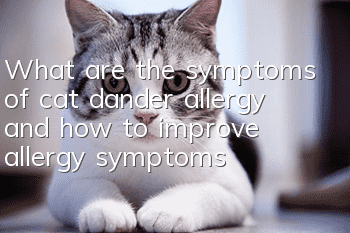What are the symptoms of cat dander allergy and how to improve allergy symptoms?

Many people believe that cat hair is a source of allergens. The main cause is cat dander, which consists of tiny dry flakes of skin that travel through the air and land on bedding, curtains, carpets and other surfaces, including human skin and clothing. The particles of cat dander are very small, about one-tenth the size of dust mites.
What are the symptoms of cat dander allergy?
· Inhale through the nose
Allergic reactions may be severe sneezing or the chronic condition of allergic rhinitis, which manifests as sneezing accompanied by a runny nose, intranasal itching, nasal congestion, and sometimes sinus congestion.
· Inhale through nose and mouth
Inhaling it into the bronchial tubes or lungs may trigger asthma, which is very dangerous. People with asthma should get an allergy test before bringing a cat home. About 30% to 40% of children/young adults with asthma are allergic to animal dander (mainly cats).
· Rash or hives
Although allergies cause only 5% to 10% of cases of chronic urticaria. Mild rashes may be caused by dander on the skin or saliva deposited by the cat licking the skin. Specific dermatitis or eczema may be aggravated by contact with cats.
·Main symptoms
sneezing;
Itchy eyes;
Difficulty breathing;
Red spots and rash appear on the body;
Itching;
How to reduce itching symptoms of cat allergy?
Although cat allergy symptoms may never completely go away, they can be reduced.
Cat allergens are airborne and require breathing to cause an allergic reaction. Cat allergens are very small, so they remain in the air for a long time, and because cats run around the house, there is a high rate of recontamination. Let’s look at suggested steps on how to reduce cat allergies.
· Avoid letting cats sleep on the bed
Although this is cruel to severe cat suckers, it is a small price to pay to relieve allergy symptoms.
·Use a HEPA air filter in rooms where cats often appear
Since allergens are difficult to remove, a good HEPA (High Efficiency Particulate Air) air purifier is essential for cleaning the air in your home.
· Wash all bedding in 140-degree hot water at least twice a month
This will eliminate dust mites and cat allergens.
· Use a HEPA vacuum to vacuum for cat allergens weekly
Carpets, floors, chairs, furniture, etc., cat allergens are everywhere, and the particles are very small and invasive, so cleaning must be done very thoroughly.
· Use a steam cleaner to clean
In addition to vacuuming, steam cleaners are also very helpful in killing cat dander embedded in carpets and furniture. Steam cleaners provide a chemical-free way to clean and kill dust mites, bacteria, mold spores and cat allergens.
· Wash your hands immediately after petting the cat and do not rub your eyes
Rubbing your eyes can cause them to itch for several hours. Use a strong antibacterial soap to avoid this problem.
·Clean your cat
Some people bathe their cats to reduce the amount of allergens they release into the air. However, the research results are somewhat contradictory to its effectiveness. Allerpet is a well-known brand of hair remover mainly used by people who are allergic to cats. Can reduce cat allergens in the air. Pour the liquid on a towel, and then gently wipe the cat to eliminate obvious cat dander until the surface of the skin is moistened, and then comb the hair smooth with a comb.
·Confining cats to a separate area
Although this is difficult, it at least keeps cat allergens contained in a single place where cleaning and air purification can be concentrated.
- How to care for a cat with a sensitive stomach?
- Scooping skills: Cats’ mental health is also important
- How vengeful is a cat?
- How often should cats take oxytocin injections? Usage and dosage of oxytocin for cats!
- Do cats succumb to violence?
- How long after the injection can a cat take a bath?
- What does "week cat" mean? It means a cat that can't last more than one week.
- Cat vomits liquid like watermelon water
- It’s not difficult to get a cat to take a bath
- What should I do if my kitten’s eyes are stuck repeatedly?



